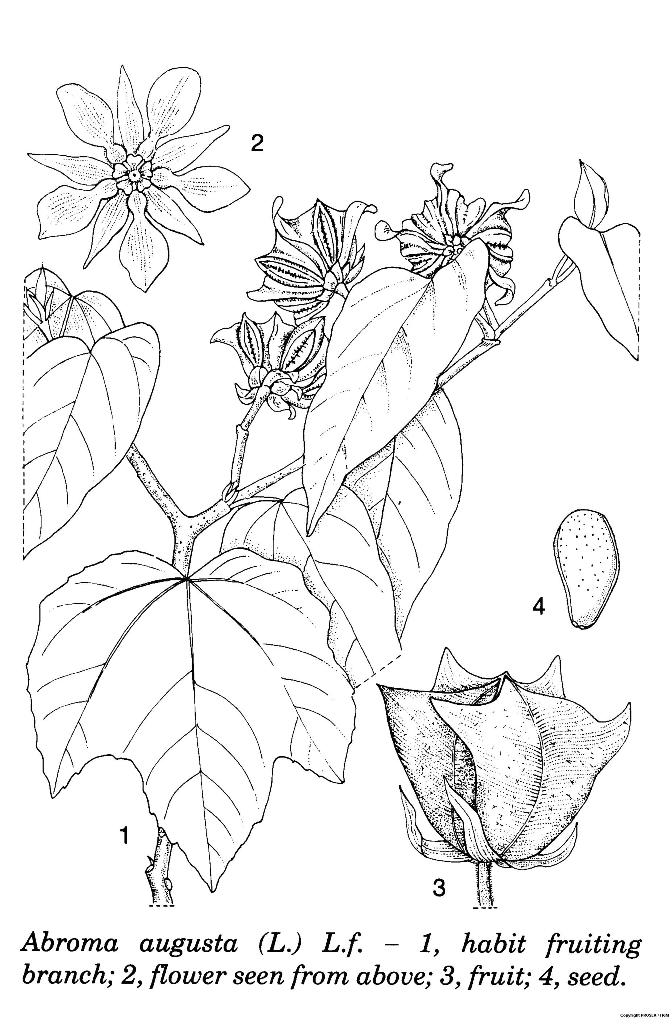Scientific Name
Abroma augusta (L.) L.f
Synonyms
Abroma alata Blanco, Abroma angulata Lam., Abroma angulosa Poir., Abroma communis Blanco, Abroma denticulata Miq., Abroma elongata Lam., Abroma fastuosa R.Br., Abroma javanica Miq., Abroma mariae Mart., Abroma mollis DC., Abroma obliqua C.Presl, Abroma sinuosa G.Nicholson, Abroma wheleri Retz., Ambroma augustum (L.) L.f., Herrania mariae (Mart.) Decne. ex Goudot, Theobroma augustum L., Theobroma mariae (Mart.) K. Schum [1].
Vernacular Name
| Malaysia | Rami sengat [2] |
| English | Devil’s cotton, perennial Indian hemp, abroma [2] |
| Indonesia | Kapasan (Javanese); kaworo (Sundanese); rebong pengayoh (Lampung) [2] |
| Philippines | Anabo (Ibanag, Ilokano, Tinggian, Tagalog, Bisaya); ambong (Tagalog); pakalkal (Pampango) [2] |
| Vietnam | Chi tai m[ef]o, b[oo]ng v[af]ng [2] |
| Thailand | Thian dam (Central); thian dam luang (Chiang Mai) [2] |
| France | Abrome, abrome royal [2]. |
Geographical Distributions
Abroma augusta is distributed from India, throughout Southeast Asia to southern China, the Solomon Islands and northern Australia. It is sometimes cultivated in India and New Guinea and experimental plantings have been set up in the Philippines and Africa (Uganda, Democratic Republic of Congo). This plant is found in thickets or tufts, secondary forests, waste places and village borders and along railways and roads, seemingly preferring forest edges and the banks of clearings or watercourses. As a light-loving plant, it does not occur in primary forests. In the Moluccas, it occurs in dry valleys on poor, sandy locations or in fallow fields [2].
Botanical Description
A. augusta is a genus from Malvaceae family. It is an erect shrub or small tree that can grow up to 2-4 m tall, normally branching at the height of 1-2 m and is often multi-stemmed from the base [2].
The stem and branches are with tenacious bark, which is smooth or armed with prickles. All parts are with prickly-pointed, irritating, stellate hairs and sometimes with glandular hairs. The orthotropic branches usually remain vegetative while flowering branches is plagiotropic [2].
The leaves are arranged alternate, simple, highly variable but two main forms exist (heterophylly), lobed (often on plagiotropic branches) or unlobed (often on orthotropic branches). The unlobed form is with petiole up to 1.5 cm long, with lance-shaped blade, measures 16-23 cm x 9-12 cm, heart-shaped at base, denticulate and palmate-pinnately veined.The lobed form is with petiole 10-40 cm long, 3-5-lobed blade, cordate-ovate in outline, measures up to 30-40 cm x 30-40 cm, with palmately 3-5-7-veined base and irregularly dentate margin [2].
The inflorescence is a leaf-opposed or terminal, 1-4-flowered cyme (usually only 1 flower develops) [2].
The flowers are pendent, 3-5 cm in diametre, bisexual and 5-merous. The peduncle and pedicel are each 1-3 cm long and slightly enlarged in fruit. The sepal is deeply divided, with 5 entire lobes, triangular, measuring about 15-20 mm x 6 mm and greenish. There are 5 petals which are spoon-shaped, measuring 2-3.5 cm x 1 cm, concave and white at base, with dark purple, red or yellow blade and fringed. The staminal tube is short, with 5 fascicles of anthers that alternate with 5 petal-like staminodes apically. Each fascicle is with 3(-4) anthers. The pistil is with a 5-lobed and 5-celled ovary which is 2-3 mm long, that contains numerous ovules, and 5 stigmatic style branches which are 1-2.5 mm long [1]. The flowering branches are usually plagiotropic [2].
The fruit is an obconical capsule, measures about 4-5 cm x 3-4 cm, rounded at base, with truncate top, 5-winged and angled, beaked sometimes, enveloped by a slightly enlarged sepal, densely prickly hairy, with apical portion loculicidal, septicidally dehiscent lateral parts and with numerous seeds [2].
The seed is cylindrical to obovoid, black, measures 3-4 mm x 2 mm, without wings or aril [2].
Cultivation
The distribution area of A. augusta is characterised by mean daily temperatures of 27-30°C in the hottest months, an average annual rainfall of at least 1500 mm, and a high relative humidity. It is not suitable for areas with a marked dry season. A. augusta is not frost-hardy and so is not found at altitudes above 1100 m. It is a short-day plant. The best soils for A. augusta are fertile alluvials with a good structure and drainage, as it does not tolerate waterlogging for a long period. However, it will also survive and grow when soil conditions are less favourable [2].
Chemical Constituent
No documentation
Plant Part Used
No documentation
Traditional Use
No documentation
Preclinical Data
No documentation
Clinical Data
No documentation
Poisonous Management
No documentation.
Line Drawing

References
- The Plant List. Ver1.1. Abroma augusta (L.) L.f. [updated 2012 April 18; cited 2014 July 8]. c2013. Available from: http://www.theplantlist.org/tpl1.1/record/kew-2610167
- Michael H. Plant Resources of South-East Asia No. 17: Fibre Plants. New Jersey: Blackwell Publishing Ltd; 2007.


